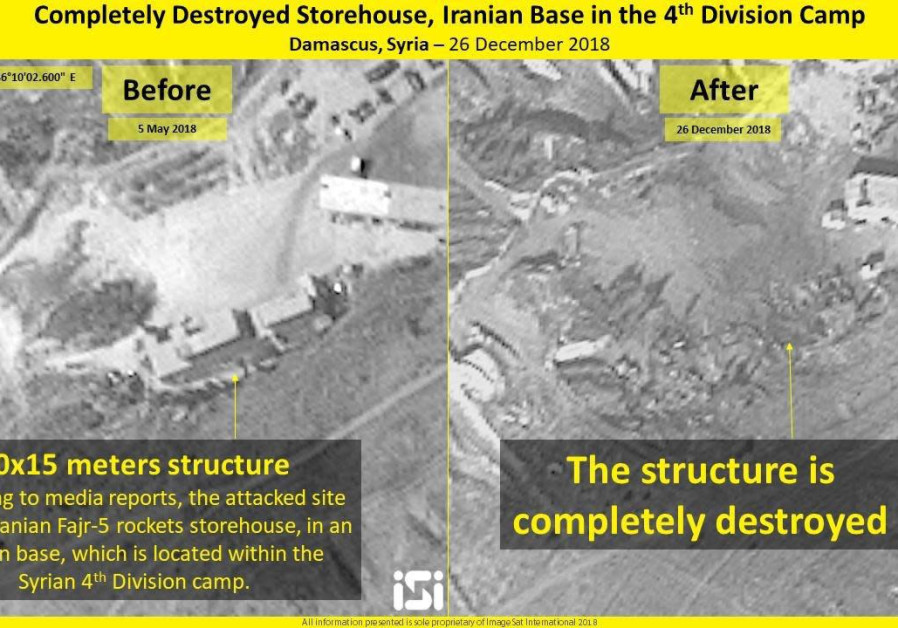Satellite shows damage to Iranian bases in Syria after alleged Israeli strike

. (photo credit: IMAGESAT INTERNATIONAL (ISI))
New satellite images of an Iranian weapons storehouse outside the Syrian capital of Damascus showed significant damage done to site following Israeli airstrikes against Iranian targets earlier in the week.
The images, taken by ImageSat International (ISI), showed the complete destruction of the 60×15 meter storehouse which supposedly held Fajr-5 missiles at an Iranian base in the Syrian regime’s 4th Division camp in the Al-Muna area.
Satellite image by @ImageSatIntl following alleged #Israeli strike on #Iranian weapons storehouse in #Syria‘s 4th Division camp outside #Damascus which held Fajr-5 missiles pic.twitter.com/Dge4jY2ztM
— Anna Ahronheim (@AAhronheim) December 27, 2018
The Fajr-5 missile can be launched from a mobile platform has has a reported range of 75 kilometers. According to ISI the site struck by the IAF on Tuesday was around 40 kilometers from Israel.
The Israeli strikes on Tuesday evening began around 10 p.m., and struck several locations in addition to the storehouse outside the capital, including military positions located in the suburbs of Damascus, air defense facilities and headquarters of the 68th Brigade and the 137th Brigade of the Syrian Army in the Damascus area, and military Unit 10 in the district of Qatana.
Syrian state media said the strikes were carried out from Lebanese airspace and that a number of “hostile targets” were intercepted by its S-200 air defense system. Israel’s air defense system was also activated, with a smoke-trail seen from the city of Hadera south of Haifa. There were no reports of injuries or damage to Israel.
Israeli officials have repeatedly voiced concerns over the growing Iranian presence on its borders and the smuggling of sophisticated weaponry to Hezbollah from Tehran to Lebanon via Syria, stressing that both are red-lines for the Jewish State.
Working to prevent the entrenchment of Iranian forces and the transfer of advanced weaponry to Hezbollah, the Israel Air Force has admitted to carrying out hundreds of airstrikes in Syria.
The alleged attack came a week after the White House announced that American troops would withdraw from Syria. Following the announcement Israeli Prime Minister Benjamin Netanyahu said that Israel would expand military operations against Iran following the withdrawal.
Israel has been “managing a campaign against Iranian forces, especially on Israel’s northern border” for the past two years, IAF Commander Maj.-Gen. Amikam Norkin said in late May just weeks after Israel’s Air Force carried out the most extensive operation in Syria since 1974, striking over 50 Iranian targets in Syria following a missile barrage of 32 Fajr-5 and Grad missiles towards Israel’s front defensive line in the Golan Heights.
In an operation called “House of Cards” dozens of positions and targets belonging to the IRGC’s Quds Force in Syria – including the launcher used to fire the rockets into Israel’s Golan Heights – were destroyed within 1.5 hours by the IAF along with the Northern Command.
Despite destroying a large amount of Iranian military hardware in the war-torn country a senior IAF officer said that Iran still has long-range capabilities to strike Israel, which has continued to strike targets in Syria.
Join Jerusalem Post Premium Plus now for just $5 and upgrade your experience with an ads-free website and exclusive content. Click here>>






Comments are closed.